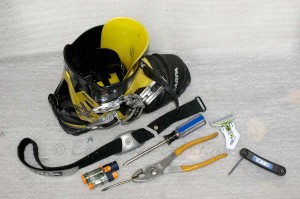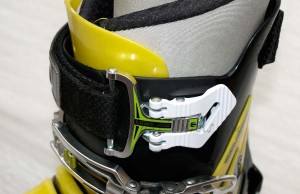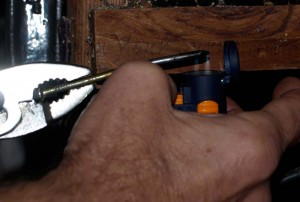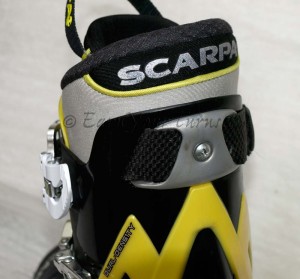The best incarnation of this is the power strap on K2’s Pinnacle 130. If you’re going to get picky about convenience, this power strap allows you to set the tension, and leave it. When you want to get out of the boot, even then you can leave the velcro strap locked in position, just detach the buckle to open the top of the cuff.
Parts and Tools

Tools: Pliers, hex keys, butane lighter,
#2 Philips screwdriver, knife.
Parts: T-nuts and bolts, power strap,
Tecnica Cochise Pro pwr strap buckle
Many power straps are secured along the Achilles spine of the cuff with a single rivet or T-nut, and they may or may not have the hole through the webbing reinforced with a grommet. That could be a wise move, if you have the right diameter and thickness grommets available. If you don’t, it is good enough to simply sear a hole in the webbing with a hot poker, either an awl or a nail. A butane torch will get the poker good and hot, but I just used a small, hand-held butane lighter and it did the trick in about 10 seconds of enveloping the tip of a nail in blue flame.
You will want to adjust the length of the velcro strap and the anchor point to optimize the contact area between the hooks and fuzz sides of the velcro before you sear a hole for bolting the strap to the spine of your boot.If your boot has a part riveted in place, you’ll want an orbital grinding head on a Dremmel to grind off one side of the rivet. It can typically be replaced with a T-nut. For this purpose, I used a 5mm deep T-nut with a 4mm X 0.7 pitch threaded nut using a 3mm hex head. With luck, you can use this same size for attaching the buckle to your boot on the side. For me, this was the easiest part of the operation.
Installing the buckle is easy IFF you swap out an existing buckle. Simply remove the top buckle and associated ladder, then replace the existing buckle with (Tecnica’s Bullrider Power Lock, #40366300003, Bullrider Power Lock). I was lucky; the installed buckle used a T-nut, not a rivet, so I just unbolted it and substituted the Cochise buckle. If you have rivets, grind the head or tail off using a Dremmel.
If you have a four-buckle boot and insist on keeping all four, but changing the power strap only you will have to get more creative and be lucky enough to have enough plastic above the top buckle to attach another one. It may end up being closer to the spine of the cuff than the side. Figure out where you want the buckle, mark the holes, check ‘er twice, then drill and insert a T-nut. Provided you have the tools, the Power Lock buckle comes with rivets you could use if you prefer.
Implementation
This is a temporary adaption of a buckled power strap to a Scarpa TX-Pro, circa 2008. The more I use this boot the less impressed I am with the original positioning of the buckles. They improved in 2010, but telemark boot development is stagnant industry wide. The most important ingredient missing, one that is easily available — theoretically — is larger cuff ROM. For greater backward range of motion the latch mechanism needs to adopt some of the technology used in Alpine Touring boots. For the average DIYer, that’s beyond the typical tool set. However, adding a buckle to the power strap is easy, doesn’t take a lot of special tools, and will yield noticeable improvements to your transition speed and convenience.
© 2013




8 comments
2 pings
Skip to comment form
Rad! And now we can also brag that we own the mythical 5 buckle boots (like amps that go to 11). I love the idea of the retrofit and can’t wait to attempt but I felt a few pieces were missing:
1) Is there a viable source for parts in lieu of cannibalizing a Cochise? Hello Booster Straps – a new product perhaps?
2) You lost me between removing the old power strap and how to install the new bucket and strap. Two new holes, or just reuse the old strap hole for the new strap but how do you mount the buckle (i.e., with a new hole)?
Ha ha, that detail was so easy I plumb forgot to mention it. Obviously! Anyway, in this instance I simply replaced the metal buckle and associated ladder with the Cochise buckle using the same hole for the regular buckle. Easy peasy. If you were adding a 5th buckle on the power strap of a 4-buckle boot you’d have to drill a hole, maybe two, and get a small T-nut or two to hold it in place. Not rocket science but you will want to apply the carpenter’s rule (measure twice – cut once). I’ll add some details to the story for others convenience. Thanks for pointing out the “obvious” missing info. Ooops.
I know this post is a bit old, but I’m just wondering where you’d suggest getting the necessary buckles?
Theoretically your local Tecnica dealer can order a set for you. The part is Tecnica’s Bullrider Power Lock, #40366300003.
Sounds like a plan. Now I wish the shop I worked in carried Tecnica…
I took your advice and modified my boots. Although I just riveted the buckle directly to the power strap.
So what happened to using the venerable booster straps? This seems a bit of an effort for a similar result.
Mmm, not sure who or what this question refers to. A buckled power strap lets you switch gears between tour and turn modes faster than a booster strap. It isn’t more “powerful” than a booster, just more convenient for touring.
[…] From a cost perspective it is probably cheaper to get the Pro Light and buy a replacement Power Lock Buckle than to buy the Pro with the PLB and replace the liner with a lighter, heat moldable liner and the sole blocks. However, if you’re interested in the Cochise it is probably more for the downhill power. The liner in the Pro will improve downhill control more than the Palau liner in the Pro Light will. In addition, the alpine style liner comes with a rubbery sole, for more comfortable apres hang time. Furthermore, most retailers will carry the replacement Dynafit-compatible sole blocks, but not the Power Lock Buckle. If you can get them to order it for you, it’s a pretty easy DIY project. […]
Thank you very much for your blog.
I enjoyed reading this article.